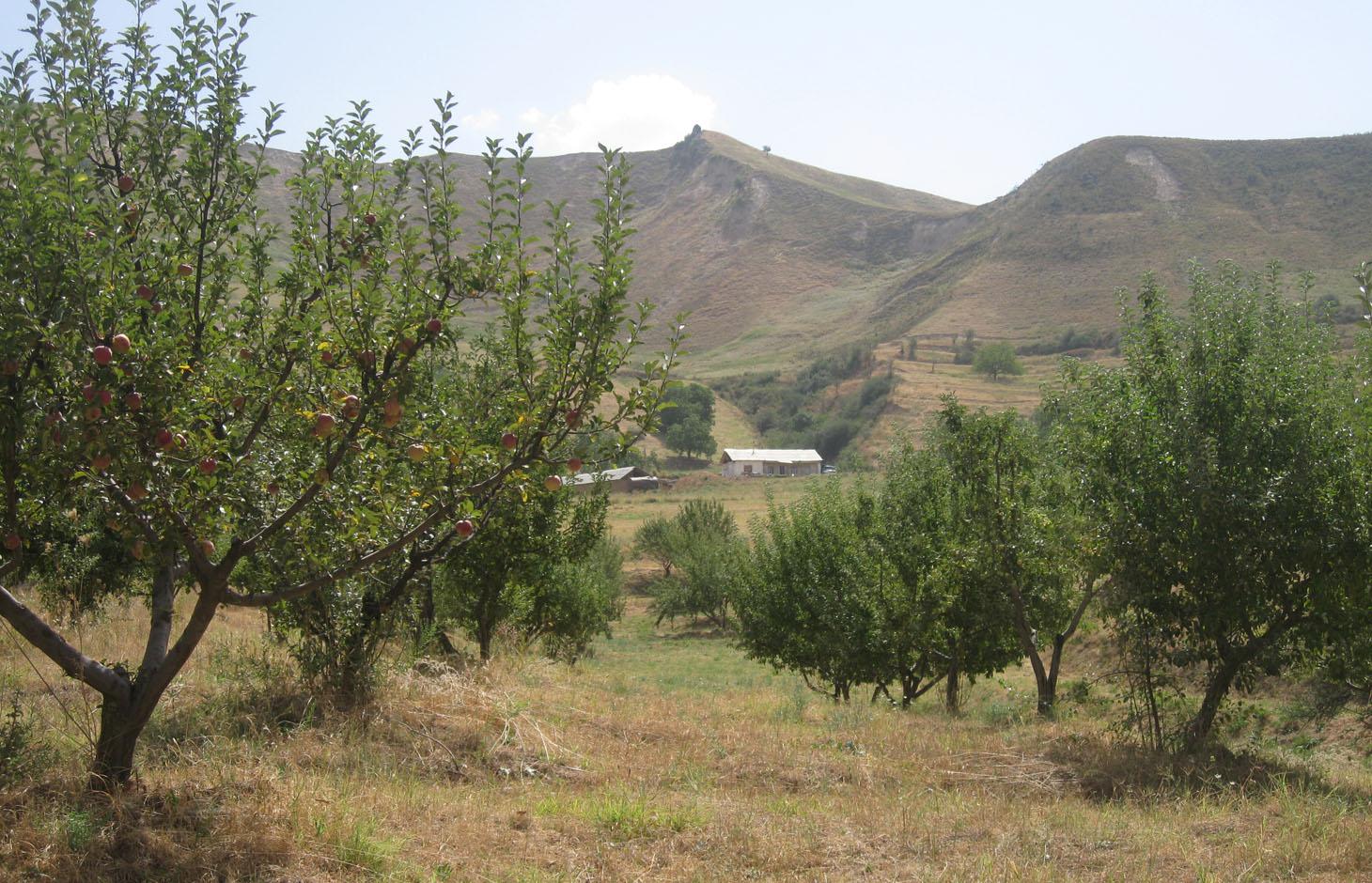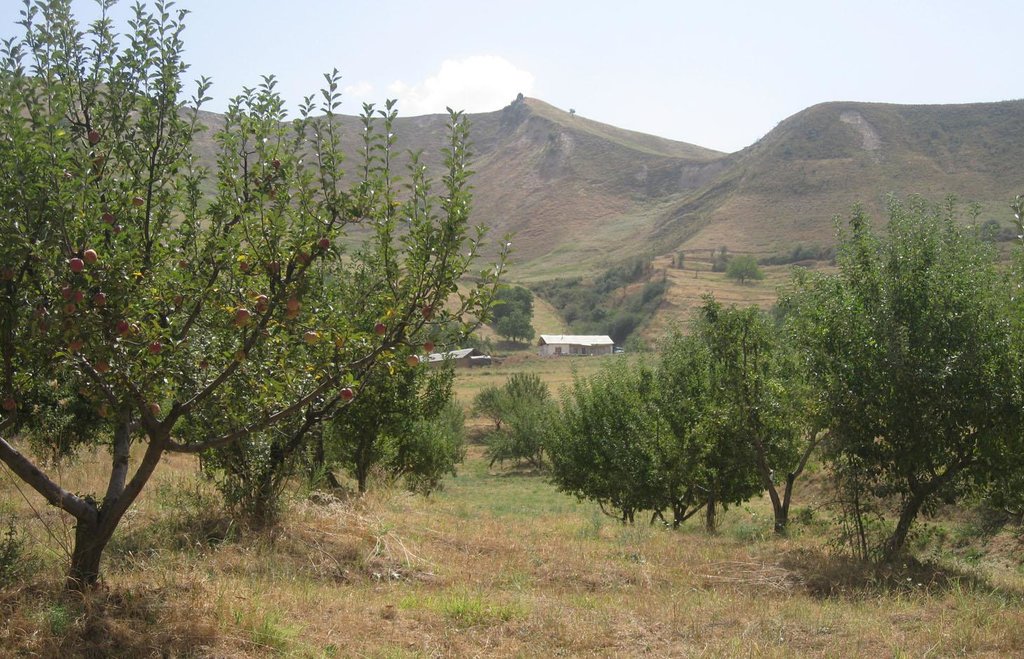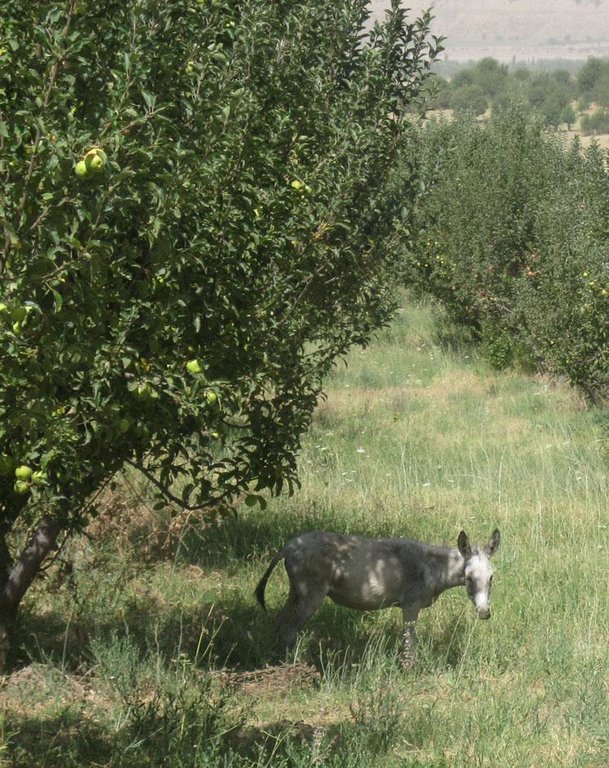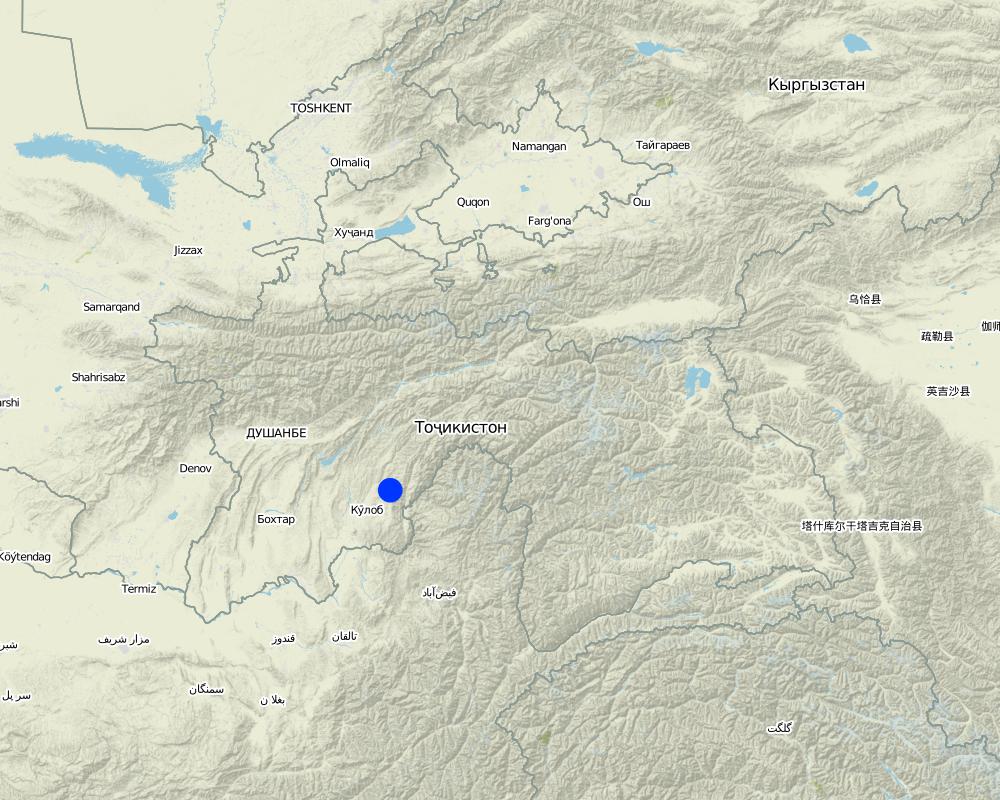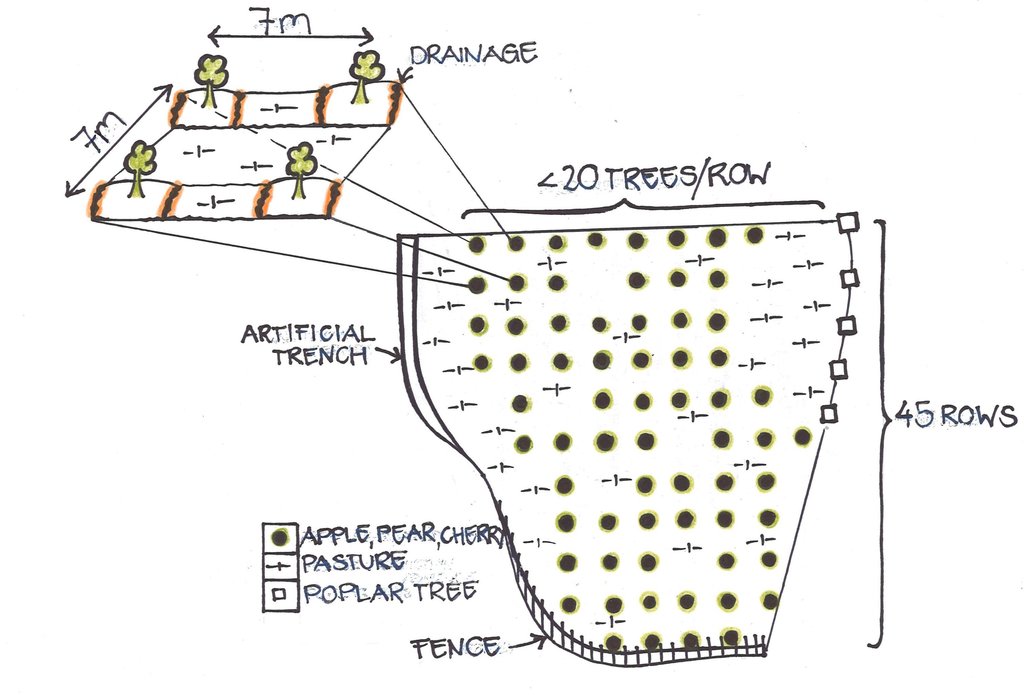Silvo-pastoralism: Orchard with integrated grazing and fodder production [Tajiquistão]
- Criação:
- Atualização:
- Compilador/a: Malgorzata Conder
- Editor: –
- Revisores: Deborah Niggli, Alexandra Gavilano
technologies_1554 - Tajiquistão
Veja as seções
Expandir tudo Recolher tudo1. Informação geral
1.2 Detalhes do contato das pessoas capacitadas e instituições envolvidas na avaliação e documentação da tecnologia
Especialista em GST:
Nome da(s) instituição(ões) que facilitou(ram) a documentação/ avaliação da Tecnologia (se relevante)
NCCR North-South (NCCR North-South) - Quirguizistão1.3 Condições em relação ao uso da informação documentada através de WOCAT
O compilador e a(s) pessoa(s) capacitada(s) aceitam as condições relativas ao uso de dados documentados através do WOCAT:
Sim
1.4 Declaração de sustentabilidade da tecnologia descrita
A tecnologia descrita aqui é problemática em relação a degradação da terra de forma que não pode ser declarada uma tecnologia de gestão sustentável de terra?
Não
2. Descrição da tecnologia de GST
2.1 Descrição curta da tecnologia
Definição da tecnologia:
Increased productivity of the land by planting fruit trees and conserving the land by restricting the access of livestock resulting in improved runoff retention
2.2 Descrição detalhada da tecnologia
Descrição:
In Soviet times, this area of totally 40 ha comprised terraces and walnut trees in the steep foothills and pastures in the lower and flatter part. After the collapse of the Soviet Era, many similar areas got degraded due to uncontrolled grazing and overuse of natural resources. The area described in this documentation, in contrast, was taken over by a family in 1991. Within the whole area of 40 ha, roads were built to improve the access and 6000 trees were planted, whereof 1200 fruit trees were planted on the pasture, conversing it into an orchard.
At present, the 6 ha of orchard are mainly consisting of three types of apple (white, golden and red), some pear and cherry trees. Several trees must have dried out or have been cut, as the farmer counts currently around 1000 fruit trees. The whole orchard is combined with pasture land. The farmer let his livestock graze in the orchard, and cuts the remaining grass in autumn, if there is still left.
The integrated orchard with pastureland and fodder production is partially fenced to hinder livestock entering his property. Furthermore, the orchard is within the range of vision which allows the farmer`s family to guard it.
The farmer who is managing the orchard today obtained the property of his father in order to continue the family project by his own initiative. By farming he ensures the livelihood of his family. Hence, he felt responsible to progress and improve the quality of life of his own family. The main reason for establishing the orchard within the grassland and to install fences, was to increase productivity of the land, bringin along beneficial effects on soil quality. According to his land users certificate, the main purpose of this land is to provide the local market with food products.
After planting, some of the seedlings were stolen or eaten by livestock from neighbouring farms. Initial labour input in the newly established orchard consisted of getting and planting the seedlings and applying pesticides. The trees are being maintained by pruning. Soil is loosened and drainage provided to increase water infiltration and to protect the trees additionally from parasites. The pasture is grazed by the livestock of the farmer. As the family only has a small number of livestock, grass is cut afterwards and used as fodder. Half of the fodder harvest belongs to the hired worker, the other half belongs to the farmer. The other tasks are executed by the farmer and his family.
The climate is semi-arid with precipitation (800mm totally) mainly during winter and spring time. Altitude is around 1380 m asl. The plot is located at the foothill, with the wider riverbed and fan downstream and overgrazed hills upstream. Bordering with the property from above, a steep slope with a dense vegetation of grafted fruit trees and walnut trees stabilizes the soil.The farmer is living with the family on the property, near the village of Momandion. In the past many livestock from nearby entered the property and grazed there. Through better control and fences less livestock is entering. The property is located directly on the road to Muminabad, the center of the District with a market- 2 km away.Considering the establishment costs of the orchard, the farmer is a fairly whealthy man, nevertheless he had to rely on his family and friends in terms of the working input.The establishment phase was a time and money consuming
2.3 Fotos da tecnologia
2.5 País/região/locais onde a tecnologia foi aplicada e que estão cobertos nesta avaliação
País:
Tajiquistão
Região/Estado/Província:
Khatlon, Tajikistan
Especificação adicional de localização:
Muminabad
Especifique a difusão da tecnologia:
- Uniformemente difundida numa área
Se a área precisa não for conhecida, indicar a área aproximada coberta:
- < 0,1 km2 (10 ha)
Comentários:
Total area covered by the SLM Technology is 0.06 km2.
Orchard is within the farmer's land property of totally 40 ha
Map
×2.6 Data da implementação
Caso o ano exato seja desconhecido, indique a data aproximada:
- 10-50 anos atrás
2.7 Introdução da tecnologia
Especifique como a tecnologia foi introduzida:
- atráves de inovação dos usuários da terra
Comentários (tipos de projeto, etc.):
22 years ago
3. Classificação da tecnologia de GST
3.1 Principal/principais finalidade(s) da tecnologia
- Melhora a produção
- Reduz, previne, recupera a degradação do solo
3.2 Tipo(s) atualizado(s) de uso da terra onde a tecnologia foi aplicada

Terra de cultivo
- Cultura de árvores e arbustos
Cultivo de árvores e arbustos - Especificar culturas:
- frutas de pomóideas (maçãs, peras, marmelos, etc.)
- frutas com caroço (pêssego, damasco, cereja, ameixa, etc.)

Pastagem
Pastagem extensiva:
- Pastoralismo semi-nômade
Comentários:
Livestock density (if relevant):
50-100 LU /km2
Major land use problems (compiler’s opinion): No major problems because of the early implementation of the technology which prevented the area of being (over)grazed without control
Major land use problems (land users’ perception): The farmer is afraid of a possible landslide on his property. Another issue is the lack of a continuous fence, because still some unwanted livestock is able to enter the orchard. He installed a water point next to his house recently.
Other grazingland: agropastoralism: first grazing and if grass is left, then cut
3.3 O uso do solo mudou devido à implementação da Tecnologia?

Pastagem
Pastagem extensiva:
- Pastoralismo semi-nômade
Comentários:
Grazing land: Extensive grazing land
3.4 Abastecimento de água
Abastecimento de água para a terra na qual a tecnologia é aplicada:
- Precipitação natural
3.5 Grupo de GST ao qual pertence a tecnologia
- Agrofloresta
- Gestão de pastoralismo e pastagem
3.6 Medidas de GST contendo a tecnologia

Medidas vegetativas
- V1: cobertura de árvores/arbustos

Medidas de gestão
- M1: Mudança no tipo de uso da terra
- M2: Mudança de gestão/nível de intensidade
Comentários:
Type of vegetative measures: aligned: -contour
3.7 Principais tipos de degradação da terra abordados pela tecnologia

Erosão do solo pela água
- Wt: Perda do solo superficial/erosão de superfície
- Wo: efeitos de degradação externa

Deteriorização física do solo
- Pc: Compactação

Degradação biológica
- Bc: redução da cobertura vegetal
Comentários:
Main causes of degradation: overgrazing (uncontrolled)
Secondary causes of degradation: population pressure (increased livestock), governance / institutional (no or undeveloped pasture management after Soviet collapse)
3.8 Redução, prevenção ou recuperação da degradação do solo
Especifique o objetivo da tecnologia em relação a degradação da terra:
- Prevenir degradação do solo
- Reduzir a degradação do solo
4. Especificações técnicas, implementação de atividades, entradas e custos
4.1 Desenho técnico da tecnologia
Especificações técnicas (relacionada ao desenho técnico):
The orchard is situated within the farmers' property which is almost completely fenced by an artificial trench, thornbush fences, poplar trees and a natural steep slope. The orchard is 6 ha in size and consists of around 45 rows, with some 20 trees per row on average. In some places trees are missing due to drying out or cutting. Currently approximately 1000 fruit trees are growing. In between the tree rows and at the borders of the orchard, grass is growing and grazed by animals, and if not entirely grazed cut for haymaking in autumn.
The fruit trees grow at a distance of 7 meters. Around the trees the soil is loosened and a tiny trench is dug, the latter serving as a rainwater drainage.
Location: Momandion. Muminabad, Khatlon, Tajikistan
Date: 14.09.2012
Technical knowledge required for land users: moderate (Good knowledge for planting required, knowledge about maintenance activities is probably more widespread amongst farmers, idea of fencing is lacking)
Main technical functions: control of concentrated runoff: retain / trap, control of concentrated runoff: impede / retard, control of concentrated runoff: drain / divert, improvement of ground cover, improvement of topsoil structure (compaction), spatial arrangement and diversification of land use
Secondary technical functions: control of raindrop splash, control of dispersed runoff: retain / trap, control of dispersed runoff: impede / retard, stabilisation of soil (eg by tree roots against land slides), increase in organic matter, increase in nutrient availability (supply, recycling,…), increase / maintain water stored in soil, increase of groundwater level / recharge of groundwater, increase of biomass (quantity), promotion of vegetation species and varieties (quality, eg palatable fodder), reduction of dry material (fuel for wildfires)
Aligned: -contour
Number of plants per (ha): 200
Vertical interval between rows / strips / blocks (m): 7
Spacing between rows / strips / blocks (m): 7
Vertical interval within rows / strips / blocks (m): 7
Width within rows / strips / blocks (m): 7
Fruit trees / shrubs species: Apple, pear, cherry
Change of land use type: change of pasture land into an orchard with integrated pasture land and fodder production (Silvopastoralism)
Change of land use practices / intensity level: Fencing hence more extensive and controlled grazing
Autor:
Conder Malgorzata
4.2 Informação geral em relação ao cálculo de entradas e custos
Outro/moeda nacional (especifique):
Somoni
Se for relevante, indique a taxa de câmbio do USD para moeda local (por exemplo, 1 USD = 79,9 Real): 1 USD =:
4,83
Indique a média salarial da mão-de-obra contratada por dia:
12.40
4.3 Atividades de implantação
| Atividade | Periodicidade (estação do ano) | |
|---|---|---|
| 1. | Buying and transport of fruit seedlings (totally 6000 seedling, whereof 1200 seedlings on for the orchard of 6 ha) | once |
| 2. | Planting fruit tree seedlings (totally 6000 seedlings, whereof 1200 seedlings for the orchard), cost according to planted trees (3 TJS per tree) | once |
| 3. | Partial fencing (of around 200m) along the property, 10.5 days, 3-4 persons | 1991 |
| 4. | Building roads for access to the house | 1991 |
4.4 Custos e entradas necessárias para a implantação
| Especifique a entrada | Unidade | Quantidade | Custos por unidade | Custos totais por entrada | % dos custos arcados pelos usuários da terra | |
|---|---|---|---|---|---|---|
| Mão-de-obra | labour | ha | 1,0 | 194,9 | 194,9 | 100,0 |
| Equipamento | machine use | ha | 1,0 | 0,7 | 0,7 | 100,0 |
| Material vegetal | seedlings | ha | 1,0 | 207,0 | 207,0 | 100,0 |
| Material de construção | fence | ha | 1,0 | 124,2 | 124,2 | 100,0 |
| Custos totais para a implantação da tecnologia | 526,8 | |||||
| Custos totais para o estabelecimento da Tecnologia em USD | 109,07 | |||||
Comentários:
Duration of establishment phase: 1 month(s)
4.5 Atividades recorrentes/manutenção
| Atividade | Periodicidade/frequência | |
|---|---|---|
| 1. | Pruning of 400 trees, ca. 40 days, 1 person, 3 TJS per tree (all trees pruned every 3 years) | spring/ once a year |
| 2. | Soil loosening around 1000 fruit trees, ca. 25 days (5 h/day), 1 person | spring/ once a year |
| 3. | Pesticides spraying once (should be done 2-3 times), 4 days (ca.5 h/d), 1 person | End of May/ once a year |
| 4. | After several years: Harvesting fruits (mainly apples) | September/every year |
| 5. | Cutting grass, by 10 people, one month, hours per day unknown. Half of straw harvest for owner, other half for the mowers as salary (4-5 Somoni/bundle). Total salary: 1000 bandles | End of summer |
| 6. | Guarding the orchard | all the time |
4.6 Custos e entradas necessárias pata a manutenção/atividades recorrentes (por ano)
| Especifique a entrada | Unidade | Quantidade | Custos por unidade | Custos totais por entrada | % dos custos arcados pelos usuários da terra | |
|---|---|---|---|---|---|---|
| Mão-de-obra | labour | ha | 1,0 | 383,3 | 383,3 | 100,0 |
| Fertilizantes e biocidas | pesticides | ha | 1,0 | 7,8 | 7,8 | 100,0 |
| Custos totais para a manutenção da tecnologia | 391,1 | |||||
| Custos totais de manutenção da Tecnologia em USD | 80,97 | |||||
Comentários:
The structural fencing is adapted from T_TAJ047. Working hours are approximate as the work was done a long time ago, with the help of many relatives with different work times. No overview over the exact work and cost input exists, tools were mainly borrowed, prices unknown. Road building done in the past was not included, because current costs were difficult to estimate. Work as guardening is not monetarised. Apple harvesting as recurrent activity (vegetative measure) is derived from T_TAJ013. In the cost summary, the fencing was calculated proportionally to one ha.
4.7 Fatores mais importantes que afetam os custos
Descreva os fatores mais determinantes que afetam os custos:
Apart from the orchard, the whole property was rebuilt with roads, fences and tree planting which caused high initial costs during the establishment phase.
5. Ambiente natural e humano
5.1 Clima
Precipitação pluviométrica anual
- <250 mm
- 251-500 mm
- 501-750 mm
- 751-1.000 mm
- 1.001-1.500 mm
- 1.501-2.000 mm
- 2.001-3.000 mm
- 3.001-4.000 mm
- > 4.000 mm
Especificações/comentários sobre a pluviosidade:
Totally 800 mm: 700mm in winter-spring, July-Sept dry season (At 1200m asl, weather station Muminabad)
Zona agroclimática
- Subúmido
Thermal climate class: temperate
5.2 Topografia
Declividade média:
- Plano (0-2%)
- Suave ondulado (3-5%)
- Ondulado (6-10%)
- Moderadamente ondulado (11-15%)
- Forte ondulado (16-30%)
- Montanhoso (31-60%)
- Escarpado (>60%)
Formas de relevo:
- Planalto/planície
- Cumes
- Encosta de serra
- Encosta de morro
- Sopés
- Fundos de vale
Zona de altitude:
- 0-100 m s.n.m.
- 101-500 m s.n.m.
- 501-1.000 m s.n.m.
- 1.001-1.500 m s.n.m.
- 1.501-2.000 m s.n.m.
- 2.001-2.500 m s.n.m.
- 2.501-3.000 m s.n.m.
- 3.001-4.000 m s.n.m.
- > 4.000 m s.n.m.
5.3 Solos
Profundidade do solo em média:
- Muito raso (0-20 cm)
- Raso (21-50 cm)
- Moderadamente profundo (51-80 cm)
- Profundo (81-120 cm)
- Muito profundo (>120 cm)
Textura do solo (solo superficial):
- Médio (limoso, siltoso)
- Fino/pesado (argila)
Matéria orgânica do solo superficial:
- Médio (1-3%)
5.4 Disponibilidade e qualidade de água
Lençol freático:
< 5 m
Disponibilidade de água de superfície:
Precário/nenhum
Qualidade da água (não tratada):
Água potável boa
5.5 Biodiversidade
Diversidade de espécies:
- Médio
5.6 Características dos usuários da terra que utilizam a tecnologia
Rendimento não agrícola:
- Menos de 10% de toda renda
Nível relativo de riqueza:
- Rico
Indivíduos ou grupos:
- Indivíduo/unidade familiar
Gênero:
- Homens
Indique outras características relevantes dos usuários da terra:
Land users applying the Technology are mainly common / average land users
Population density: 100-200 persons/km2
Annual population growth: 1% - 2%
5.7 Área média de terrenos utilizados pelos usuários de terrenos que aplicam a Tecnologia
- < 0,5 ha
- 0,5-1 ha
- 1-2 ha
- 2-5 ha
- 5-15 ha
- 15-50 ha
- 50-100 ha
- 100-500 ha
- 500-1.000 ha
- 1.000-10.000 ha
- > 10.000 ha
É considerado pequena, média ou grande escala (referente ao contexto local)?
- Média escala
5.8 Propriedade de terra, direitos de uso da terra e de uso da água
Propriedade da terra:
- Estado
Direitos do uso da terra:
- Arrendado
Direitos do uso da água:
- Comunitário (organizado)
- Indivíduo
Comentários:
Land ownership is based on the land user certificate conferred by the government.
5.9 Acesso a serviços e infraestrutura
Saúde:
- Pobre
- Moderado
- Bom
Educação:
- Pobre
- Moderado
- Bom
Assistência técnica:
- Pobre
- Moderado
- Bom
Emprego (p. ex. não agrícola):
- Pobre
- Moderado
- Bom
Mercados:
- Pobre
- Moderado
- Bom
Energia:
- Pobre
- Moderado
- Bom
Vias e transporte:
- Pobre
- Moderado
- Bom
Água potável e saneamento:
- Pobre
- Moderado
- Bom
Serviços financeiros:
- Pobre
- Moderado
- Bom
6. Impactos e declarações finais
6.1 Impactos no local mostrados pela tecnologia
Impactos socioeconômicos
Produção
Produção agrícola
Produção de forragens
Qualidade da forragem
Produção animal
Comentários/especificar:
As the area of the orchard with pasture is fenced it is not an communal pasture anymore as it was before
Produção de madeira
Comentários/especificar:
From pruning
Diversidade de produtos
Área de produção
Disponibilidade e qualidade de água
Demanda por água para irrigação
Renda e custos
Despesas com insumos agrícolas
Rendimento agrícola
Diversidade de fontes de rendimento
Impactos socioculturais
Segurança alimentar/auto-suficiência
Estado de saúde
Atenuação de conflitos
contribution to human well-being
Comentários/especificar:
Products for market leading to higher income, sharing of some knowledge about management of private land enhances dissemination and exchange of information/knowledge.
Impactos ecológicos
Ciclo hídrico/escoamento
Escoamento superficial
Solo
Umidade do solo
Cobertura do solo
Perda de solo
Ressecamento/ selagem do solo
Compactação do solo
Ciclo e recarga de nutrientes
Matéria orgânica do solo/carbono abaixo do solo
Biodiversidade: vegetação, animais
Biomassa/carbono acima do solo
Controle de praga/doença
Clima e redução de riscos de desastre
Risco de incêndio
6.2 Impactos externos mostrados pela tecnologia
Cheias de jusante
Capacidade de tamponamento/filtragem
Danos em áreas vizinhas
6.3 Exposição e sensibilidade da tecnologia às mudanças climáticas graduais e extremos/desastres relacionados ao clima (conforme o ponto de vista dos usuários da terra)
Mudança climática gradual
Mudança climática gradual
| Estação do ano | aumento ou diminuição | Como a tecnologia lida com isso? | |
|---|---|---|---|
| Temperatura anual | aumento | não bem |
Extremos (desastres) relacionados ao clima
Desastres meteorológicos
| Como a tecnologia lida com isso? | |
|---|---|
| Temporal local | bem |
| Tempestade de vento local | bem |
Desastres climatológicos
| Como a tecnologia lida com isso? | |
|---|---|
| Seca | não bem |
Desastres hidrológicos
| Como a tecnologia lida com isso? | |
|---|---|
| Inundação geral (rio) | bem |
Outras consequências relacionadas ao clima
Outras consequências relacionadas ao clima
| Como a tecnologia lida com isso? | |
|---|---|
| Período de crescimento reduzido | não bem |
6.4 Análise do custo-benefício
Como os benefícios se comparam aos custos de implantação (do ponto de vista dos usuários da terra)?
Retornos a curto prazo:
levemente positivo
Retornos a longo prazo:
positivo
Como os benefícios se comparam aos custos recorrentes/de manutenção(do ponto de vista dos usuários da terra)?
Retornos a curto prazo:
positivo
Retornos a longo prazo:
positivo
Comentários:
Family project to improve the quality of life of the family. Costs were high at the beginning with little outcomes, now there is less labour required and the outcome is high.
6.5 Adoção da tecnologia
Comentários:
1 land user families have adopted the Technology without any external material support
Even though they neighbours see the whealty orchard, the farmer din not see any other farmers adapting this Technology. Reasons are unknwon.
There is no trend towards spontaneous adoption of the Technology
6.7 Pontos fortes/vantagens/oportunidades da tecnologia
| Pontos fortes/vantagens/oportunidades na visão do usuário da terra |
|---|
| Giving good yield and "cash crop" hence having success in the project of the family |
| Better quality of fodder and less damages due to intrusive livestock |
| Pontos fortes/vantagens/oportunidades na visão do compilador ou de outra pessoa capacitada |
|---|
| Thanks to the establishment time, right after the collapse of the Soviet Union, when land was generally well conserved, the technology worked as a preventive measure. |
| Silvopastoralism not only raises productivity of the same plot as an orchard and pasture is combined, but also enables mutual benefits (p.e.rooting system raises soil moisture, which is again improving vegetation cover). |
| The technology might work as exemplary model for other farmers |
6.8 Pontos fracos, desvantagens/riscos da tecnologia e formas de superá-los
| Pontos fracos/desvantagens/riscos na visão do usuário da terra | Como eles podem ser superados? |
|---|---|
| There is always work to do, without input no (good) output. |
| Pontos fracos/vantagens/riscos na visão do compilador ou de outra pessoa capacitada | Como eles podem ser superados? |
|---|---|
| For the farmer, the economic benefit is more important than the ecologic benefit. Especially, there is missing sensibility of the farmer concerning the application of pesticides (quantity, type). | A workshop which provides guidelines on optimal use of pesticides (type and quantities of pesticides, timing and frequency of application etc.) |
| The establishment of orchards is more efficient on big plots of land, which often prevents poor farmers with small plots from establishing orchards. | Creating incentives to change land use, by combining plots from different land owners, which will allow to share costs for establishment and maintenance. Yields should be clearly attributed to the individual farmers. |
7. Referências e links
7.1 Métodos/fontes de informação
- visitas de campo, pesquisas de campo
- entrevistas com usuários de terras
Quando os dados foram compilados (no campo)?
19/07/2012
Links e módulos
Expandir tudo Recolher tudoLinks
Não há links
Módulos
Não há módulos


